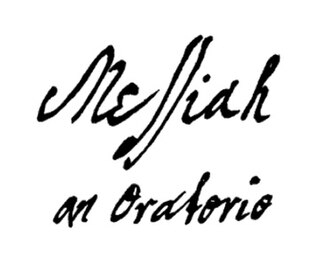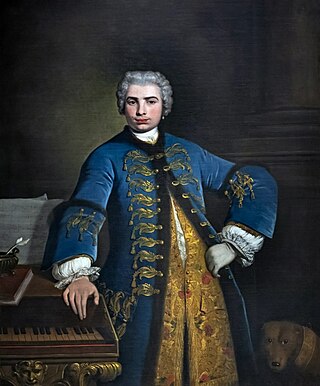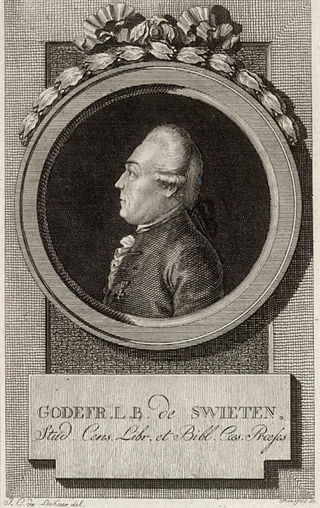Related Research Articles

In music, an aria is a self-contained piece for one voice, with or without instrumental or orchestral accompaniment, normally part of a larger work.
A soprano is a type of classical female singing voice and has the highest vocal range of all voice types. The soprano's vocal range (using scientific pitch notation) is from approximately middle C (C4) = 261 Hz to "high A" (A5) = 880 Hz in choral music, or to "soprano C" (C6, two octaves above middle C) = 1046 Hz or higher in operatic music. In four-part chorale style harmony, the soprano takes the highest part, which often encompasses the melody. The soprano voice type is generally divided into the coloratura, soubrette, lyric, spinto, and dramatic soprano.
A countertenor (also contra tenor) is a type of classical male singing voice whose vocal range is equivalent to that of the female contralto or mezzo-soprano voice types, generally extending from around G3 to D5 or E5, although a sopranist (a specific kind of countertenor) may match the soprano's range of around C4 to C6. Countertenors often have tenor or baritone chest voices, but sing in falsetto or head voice much more often than they do in their chest voice.
A contralto is a type of classical female singing voice whose vocal range is the lowest female voice type.
An oratorio is a musical composition with dramatic or narrative text for choir, soloists and orchestra or other ensemble.

Messiah is an English-language oratorio composed in 1741 by George Frideric Handel. The text was compiled from the King James Bible and the Coverdale Psalter by Charles Jennens. It was first performed in Dublin on 13 April 1742 and received its London premiere a year later. After an initially modest public reception, the oratorio gained in popularity, eventually becoming one of the best-known and most frequently performed choral works in Western music.
A mezzo-soprano or mezzo (; Italian:[ˌmɛddzosoˈpraːno]; meaning "half soprano") is a type of classical female singing voice whose vocal range lies between the soprano and the contralto voice types. The mezzo-soprano's vocal range usually extends from the A below middle C to the A two octaves above (i.e. A3–A5 in scientific pitch notation, where middle C = C4; 220–880 Hz). In the lower and upper extremes, some mezzo-sopranos may extend down to the F below middle C (F3, 175 Hz) and as high as "high C" (C6, 1047 Hz). The mezzo-soprano voice type is generally divided into the coloratura, lyric, and dramatic.
Melisma is the singing of a single syllable of text while moving between several different notes in succession. Music sung in this style is referred to as melismatic, as opposed to syllabic, in which each syllable of text is matched to a single note. An informal term for melisma is a vocal run. The term roulade is also sometimes used interchangeably with melisma.

Recitative is a style of delivery in which a singer is allowed to adopt the rhythms and delivery of ordinary speech. Recitative does not repeat lines as formally composed songs do. It resembles sung ordinary speech more than a formal musical composition.

Coloratura is an elaborate melody with runs, trills, wide leaps, or similar virtuoso-like material, or a passage of such music. Operatic roles in which such music plays a prominent part, and singers of these roles, are also called coloratura. Its instrumental equivalent is ornamentation.

Agrippina is an opera seria in three acts by George Frideric Handel with a libretto by Cardinal Vincenzo Grimani. Composed for the 1709–10 Venice Carnevale season, the opera tells the story of Agrippina, the mother of Nero, as she plots the downfall of the Roman Emperor Claudius and the installation of her son as emperor. Grimani's libretto, considered one of the best that Handel set, is an "anti-heroic satirical comedy", full of topical political allusions. Some analysts believe that it reflects Grimani's political and diplomatic rivalry with Pope Clement XI.
A coloratura soprano is a type of operatic soprano voice that specializes in music that is distinguished by agile runs, leaps and trills.
Bel canto —with several similar constructions —is a term with several meanings that relate to Italian singing.

Saul is a dramatic oratorio in three acts written by George Frideric Handel with a libretto by Charles Jennens. Taken from the First Book of Samuel, the story of Saul focuses on the first king of Israel's relationship with his eventual successor, David—one which turns from admiration to envy and hatred, ultimately leading to the downfall of the eponymous monarch. The work, which Handel composed in 1738, includes the famous "Dead March", a funeral anthem for Saul and his son Jonathan following their deaths in the Battle of Mount Gilboa at the hands of the Philistines, and some of the composer's most dramatic choral pieces. Saul was first performed at the King's Theatre in London on 16 January 1739. The work was a success at its London premiere and was revived by Handel in subsequent seasons. Notable modern-day performances of Saul include that at Glyndebourne in 2015.

Solomon, HWV 67, is an oratorio by George Frideric Handel. The anonymous libretto – currently thought to have been penned by the English Jewish poet/playwright Moses Mendes (d.1758) – is based on the biblical stories of the wise king Solomon from the First Book of Kings and the Second Book of Chronicles, with additional material from Antiquities of the Jews by ancient historian Flavius Josephus. The music was composed between 5 May and 13 June 1748, and the first performance took place on 17 March 1749, with Caterina Galli in the title role at the Covent Garden Theatre in London, where it had two further performances. Handel revived the work in 1759.

Messiah, the English-language oratorio composed by George Frideric Handel in 1741, is structured in three parts, listed here in tables for their musical setting and biblical sources.

Messiah, the English-language oratorio composed by George Frideric Handel in 1741, is structured in three parts. The wordbook was supplied by Charles Jennens. This article covers Part I and describes the relation of the musical setting to the text. Part I begins with the prophecy of the Messiah and his virgin birth by several prophets, namely Isaiah. His birth is still rendered in words by Isaiah, followed by the annunciation to the shepherds as the only scene from a Gospel in the oratorio, and reflections on the Messiah's deeds. Part II covers the Passion, death, resurrection, ascension, and the later spreading of the Gospel. Part III concentrates on Paul's teaching of the resurrection of the dead and Christ's glorification in heaven.

Messiah, the English-language oratorio composed by George Frideric Handel in 1741, is structured in three parts. This listing covers Part II in a table and comments on individual movements, reflecting the relation of the musical setting to the text. Part I begins with the prophecy of the Messiah and his birth, shows the annunciation to the shepherds and reflects the Messiah's deeds on earth. Part II covers the Passion in nine movements including the oratorio's longest movement, an air for alto He was despised, then mentions death, resurrection, ascension, and reflects the spreading of the Gospel and its rejection. The part is concluded by a scene called "God's Triumph" that culminates in the Hallelujah chorus. Part III of the oratorio concentrates on Paul's teaching of the resurrection of the dead and Christ's glorification in heaven.

Messiah, the English-language oratorio composed by George Frideric Handel in 1741, is structured in three parts. This listing covers Part III in a table and comments on individual movements, reflecting the relation of the musical setting to the text. Part I begins with the prophecy of the Messiah and his birth, shows the annunciation to the shepherds as a scene from the Gospel of Luke, and reflects the Messiah's deeds on Earth. Part II covers the Passion, death, resurrection, ascension, and the later spreading of the Gospel. Part III concentrates on Paul's teaching of the resurrection of the dead and Christ's glorification in heaven.

Der Messias, K. 572, is Wolfgang Amadeus Mozart's 1789 German-language version of Messiah, George Frideric Handel's 1741 oratorio. On the initiative of Gottfried van Swieten, Mozart adapted Handel's work for performances in Vienna.
References
- 1 2 3 4 5 6 7 Kenneth Kreitner, Louis Jambou, Desmond Hunter, Stewart A. Carter, Peter Walls, Kah-Ming Ng, David Schulenberg and Clive Brown (2001). "Ornaments". Grove Music Online . Oxford Music Online. Oxford University Press. doi:10.1093/gmo/9781561592630.article.49928. ISBN 9781561592630.
{{cite encyclopedia}}: CS1 maint: multiple names: authors list (link) - 1 2 3 William Berger (2002). NPR The Curious Listener's Guide to Opera. Penguin Publishing Group. ISBN 9781101221174.
- 1 2 3 Piero Weiss, Richard Taruskin (2007). "Glossary: Roulade". Music in the Western World. Cengage Learning. p. 555. ISBN 9781111793449.
- 1 2 Louis C. Elson, ed. (1911). "Melisma". Modern Music and Musicians; Part Two: Encyclopedia. University Society. p. 803. ISBN 9781404706750.
- ↑ Theodore Karp (1983). Dictionary of music. Northwestern University Press. p. 340. ISBN 9780810106598.
- ↑ Howard E. Smither (2012). A History of the Oratorio, Vol. IV. University of North Carolina Press. p. 549. ISBN 9780807837788.
- ↑ Burton D. Fisher (2005). A History of Opera: Milestones and Metamorphoses. Opera Journeys Publishing. p. 422. ISBN 9781930841987.
- ↑ José Joaquín de Virués y Spínola (1850). An original and condensed grammar of harmony, counterpoint, and musical composition ; or, The generation of euphony reduced to natural truth : preceded by the Elements of music. Longman, Brown, Green, & Longman. p. 17.
- 1 2 Esther Singleton (1902). A Guide to the Opera: Description & Interpretation of the Words & Music of the Celebrated Operas. Dodd, Mead & Co. p. xvi.
- ↑ D. E. Hervey (1894). William Smythe Babcock Mathews (ed.). "Handel in the Nineteenth Century". Music: A Monthly Magazine, Devoted to the Art, Science, Technic and Literature of Music. 5: 660.
- ↑ Glenn Hinson (2010). "Fire in My Bones: Transcendence and the Holy Spirit in African American Gospel". University of Pennsylvania Press. p. 194. ISBN 978-0812203011.
- ↑ The Foundations of Rock: From "Blue Suede Shoes" to "Suite: Judy Blue Eyes". Oxford University Press. 5 March 2009. p. 169. ISBN 9780195310238.